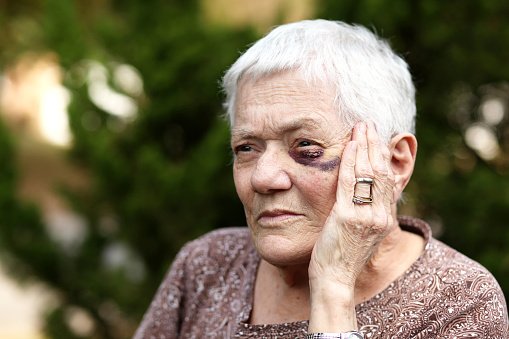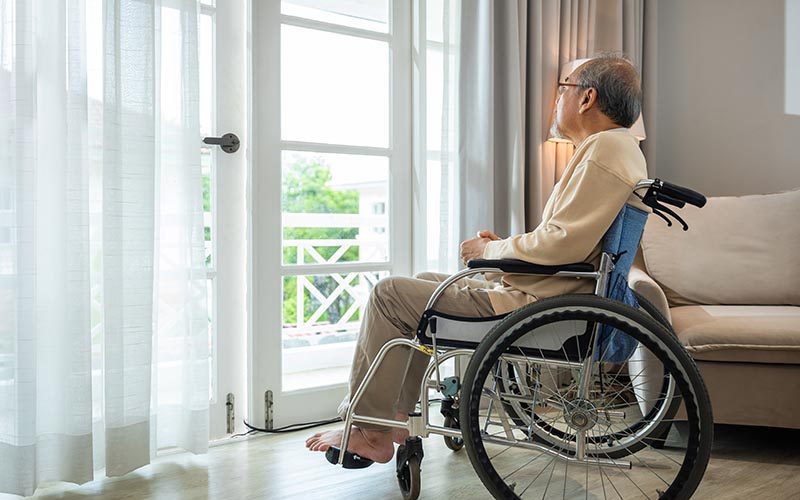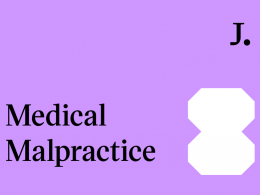The second-to-last stage of pressure sore progression is Stage 3 bedsores. As the sore has reached the fat tissue, it is now possible for the patient to become infected. As a rule, nursing homes can prevent bedsore stage 3 by providing adequate care to patients with mobility problems. See if you can file a lawsuit on behalf of a loved one who was harmed.
If a patient is subjected to prolonged compression of the soft tissue between a bone prominence and a surface, the result is a localized area of necrosis. Stage 3 wounds
have full-thickness skin loss that may extend into the subcutaneous tissue layer. Stage 4 pressure ulcers go deeper, revealing the beneath muscle, tendon, cartilage, or bone.
When treating pressure sores, patients should prioritize preventing pressure ulcer complications. It is advisable to get professional medical advice when there are decubitus ulcers or suspected deep tissue injury covered with dead tissue.
Good nursing home staff members would help prevent severe bedsores, pressure injuries, or open wounds in a nursing home resident.
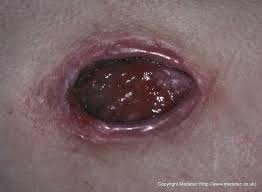
What Stage of Pressure Sores Am I Dealing With?
Pressure sores are sometimes called bed sores, and they’ve been known for many years. It occurs because your legs tend to collapse when you sit on a chair. You may get them while you are asleep or in the wheelchair. Your physician can tell you what stages are involved with pressure sores.
The stages depend upon the sore’s severity, and the treatment’s severity may vary from person to person. If it is found early, they may easily heal quickly, without discomfort or irritation. It will only worsen with treatment
The skin will be smoother when the sore is larger and swollen pink tissues are visible. One of the most common ones is stage 3 ulcer due to its severity.
Stage 3 Bedsores – Causes, Symptoms & Treatment
The Bedsores Stage 3 represents the second and last stages of pressure sores. Initially, a sore has absorbed fat tissue through every layer of skin and exposes the patient to infection.
Nursing home patients can often avoid stage three bedsores by properly assisting the patient with mobility challenges.
If you feel that someone is being hurt, contact a lawyer to know about your entitlements, bedsores images could help make your case easier.
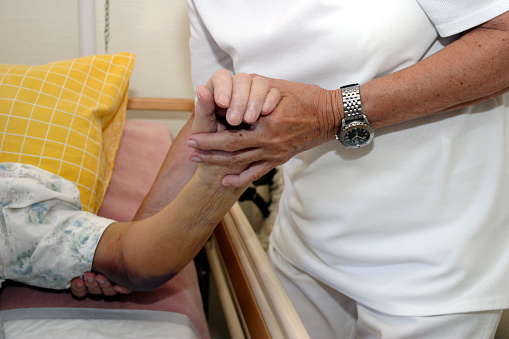
Stage 3 Bedsores in Nursing Facilities
Stage three bruising can penetrate the skin, causing extremely deep bruising. The wound could cause severe illness and death in nursing homes, such as sepsis. A stage 3 bedsore can be prevented in nursing homes if nursing workers treat earlier-stage pains.
A nursing care facility can offer legal advice to someone who develops stage three bedsores.
Pressure Ulcers, Stages 3 and 4
Pressure ulcers occur in vascular and soft tissue areas where tissue has been compressed between the surface of a bone for extended periods. A stage 3 sacral ulcer
involves thicker skin that extends to the subcutaneous skin layers.
Stage IV pain ulcers expand further, exposing muscles, cartilage, and bone.
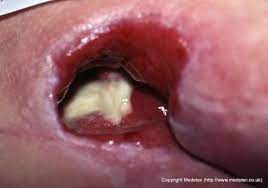
Learn More About Stage 3 Bedsores
Bedsores, pressure ulcers, or decubital ulcers are grouped according to the severity in 4 different stages. Stage 3 bedsores burst through the dermoid (second layer skin layers) and penetrate underneath. Stage 3 bedsores can cause an infection that could last a couple of months.
Some pressure sores can progress through the fourth and most hazardous stages if not treated properly. A nursing facility that employs adequately qualified staff may offer the care that prevents bed sores. If nursing homes suffer stage three-bed sores, it may mean they aren’t nicely cared for.
Keep reading if you are wondering which type of wound may have no symptoms, at least in the early stages based on classifications.
Stage 2
It occurs when sores penetrate deep into the skin underneath your skin. What’s wrong with your skin? Symptoms are broken skin. Signs of swelling include hot and red eyes. It may also contain fluids and puss. I think it’s hard. Tell me about the next step in the first phase.
As a sanitizer, wash the wounds thoroughly. It might hurt, so ask a physician for pain relief 30 minutes to 45 minutes before cleaning. Cover your irritated skin with a slick dressing with wet gauze. Immediately tell your medical provider if your symptoms are severe, rash, or swelling.
Stage 1
It’s the mildest stage. Pressure sores affect only your inner layer. Symptoms: Pain, blisters, or itchy is a frequent symptoms. It may feel softer, firm, warmer, or more relaxed. You might see red spots.
If your skin is darker, it can make detecting the discolored part challenging. The spot will remain light for up to a minute when you press. So less blood reaches the area.
When experiencing pressure sores, it is essential to stop the pressure on your body. Place yourself on an adjustable bed or use foam cushions or mattresses for comfort.
Diagnosis of Bedsores in the Third Stage
Symptoms or a deeper incision generating puffy skin might diagnose bedsores. Your doctor may examine the wound’s surface for sensitivity and stages. Staging helps decide the best treatment. Stages 1 and 2 are painful.
Deepness in Wounds stage 3 Bedsores can be defined as a more profound tissue injury. Tunnel wounds penetrate the skin and the underlying tissue but are not confined to bone or muscle.
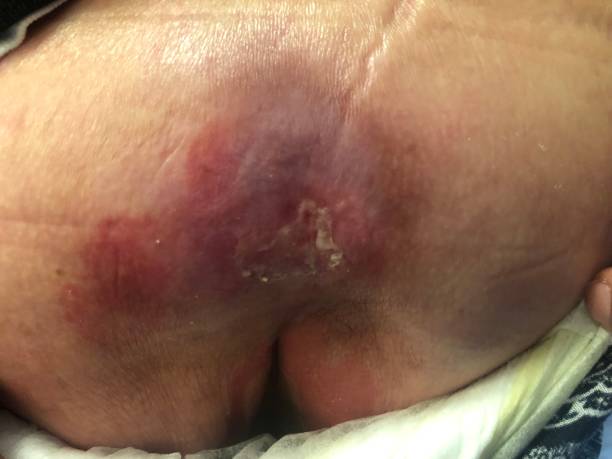
The Diagnostic Challenges of Stage 3 Bedsore
There is no definitive cure or diagnostic procedure for Stage 3 bedsore. Bedsores can’t be stopped unless the area is sloughed or covered with eschar. It can only happen after the removal by doctors of these sores. Sometimes doctors have no intention of removing Eschar.
The eschars that develop in bedsores near the heel signal the healing of this sore. Luckily, doctors may treat bedsores without the need for staging. So get medical attention immediately.
Taking Care of Bed Sores That Are in Stage 3
Even if treated, the bedsores may take about one month to heal. If bedsores are not removed, they can cause serious complications. A bed-or-bed infection at stage 2 can result in a bed-or-bed disease at stage 3. Often this stage leads to severe and potentially fatal consequences such as death.
Etiology of Bedsores
Three different tissues accept the pressure ulcer as the cause: Longer pressure: In most cases, this pressure causes the bone to bind to the surface, as in supines, for long periods. When pressures above tissue capillaries increase, the surrounding tissues deplete oxygen.
The forces are generally triggered if patients remain in a single area while the skin splinters and the deep fascia swell, and this pressure can cause the blood vessels to collapse.

Treating Stage 3 Bedsores
The proper treatment of the wounds will help initiate the healing of pressure wound injuries. Patients suffering from Stage 3 bedsores need immediate medical attention. Stage 3 bedsores treatment may involve: Usually, deep sores require surgical treatment, but they tend to heal quickly.
Nevertheless, treatment is essential because there may not be any other possible cause for the bedsores. Are there other people suffering from stage three bedsores that need justice? Speak to JustPoint now.
Stage 3
The pain has penetrated the fat and skin layers at this stage. It appears like a crater and has a toxic smell. There can be some signs of infection like bleeding and redness of a wound. Usually, the blood vessels surrounding the sores are black.
What Does a Stage 3 Pressure Sore Look Like?
Scrape (abrasion), blister, or shallow skin crater can all be signs of this condition. This stage can sometimes resemble a blister with a clear fluid inside. The skin may be damaged beyond repair or even die at this point.
In the third stage, the sore worsens and forms a small crater in the tissue beneath the skin.
How Serious Is a Stage 3 Bedsore?
A stage 3 bedsore is a deep tissue injury. It is a tunneling wound that penetrates the top layers of skin and underlying tissue, not the bone or muscle. Seek immediate medical attention if your loved one has or may have a stage 3 bedsore. Bedsores pose a severe health risk and need to be treated promptly.
How Long Does It Take To Get a Stage 3 Pressure Ulcer?
Grade 3 or 4 pressure ulcers can develop quickly. For example, in susceptible people, a full-thickness pressure ulcer can sometimes develop in just 1 or 2 hours. However, in some cases, the damage will only become apparent a few days after the injury.
What Type of Dressing Is Used for a Stage 3 Pressure Ulcer?
Alginate dressings, which have many of the same properties as foam, are another choice for Stage three pressure ulcers.
What Is the Best Way to Treat the Stage Three Bedsores?
Get the doctors’ advice. They can bury the dead tissue and give antibiotics to prevent infection. In addition, you can buy a mattress with your insurance. Stage 3 pressure sores take about three months to heal themselves.
Life Expectancy of People With Stage Three Bed Sore
Life expectancies for people with Stage 3 bedsores vary according to their medical condition. Stage 3 bedsores aren’t fatal but likely related to other medical issues.
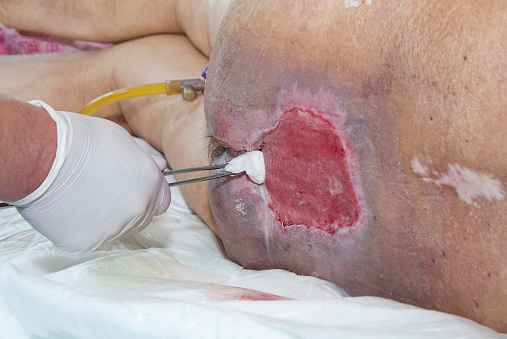
Symptoms of Stage 3 and Stage 4 Pressure Ulcers
Stage 3 and IV pressure ulcers are deep infiltration in deep underlying tissue and cause more severe damage. Stage 3 includes total thickness and may reach subcutaneous skin; granulation tissues and epiboly (rolled skin) are frequently present.
The wound could be undermining, or tunneling, which can cause more damage than the superficial surface would suggest to the patient. Pressure ulcers in stage 4 extend deep and penetrate muscle tissue or ligaments.
Causes of Stage 3 Bedsores
Nursing home residents can develop bedsores by sitting on bedsores for an extended duration. It causes pressure and cuts blood flow which causes irritation and damages cellular tissue.
Stage three bedsores extend to the second surface of the skin (the dermis) or the skin underneath the skin’s surface.
Symptoms of Stage 3 Bedsores
Stage 3 bedsores are usually characterized by scaly skin that develops crater-like wounds. Fat tissue may also be observed. Symptoms of bacterial infections can be seen. Signs of an Infecting Stage Three Bedsore: A fractured bone may indicate a condition.
What Is Stage 3 Pressure Ulcer?
Stage 3 bedsores are painful skin wounds that occur mainly on deep layers of skin. This stage is 3rd of four bedsores. Typically they develop after Stage 2 bedsores penetrate through the skin surface without reaching muscles or bones.
What Do Stage 3 Bed Sores Look Like?
At stage three, this sore has passed from the skin into the fat. The significant symptom is that the sore appears like a crater like wound due to poor skin care and prolonged stagnation in the same position. The family members deserve excellent legal compensation for elder abuse by health care providers.
Let us get you the legal help you deserve for your life threatening infections by filling the form below for a free legal case review.






